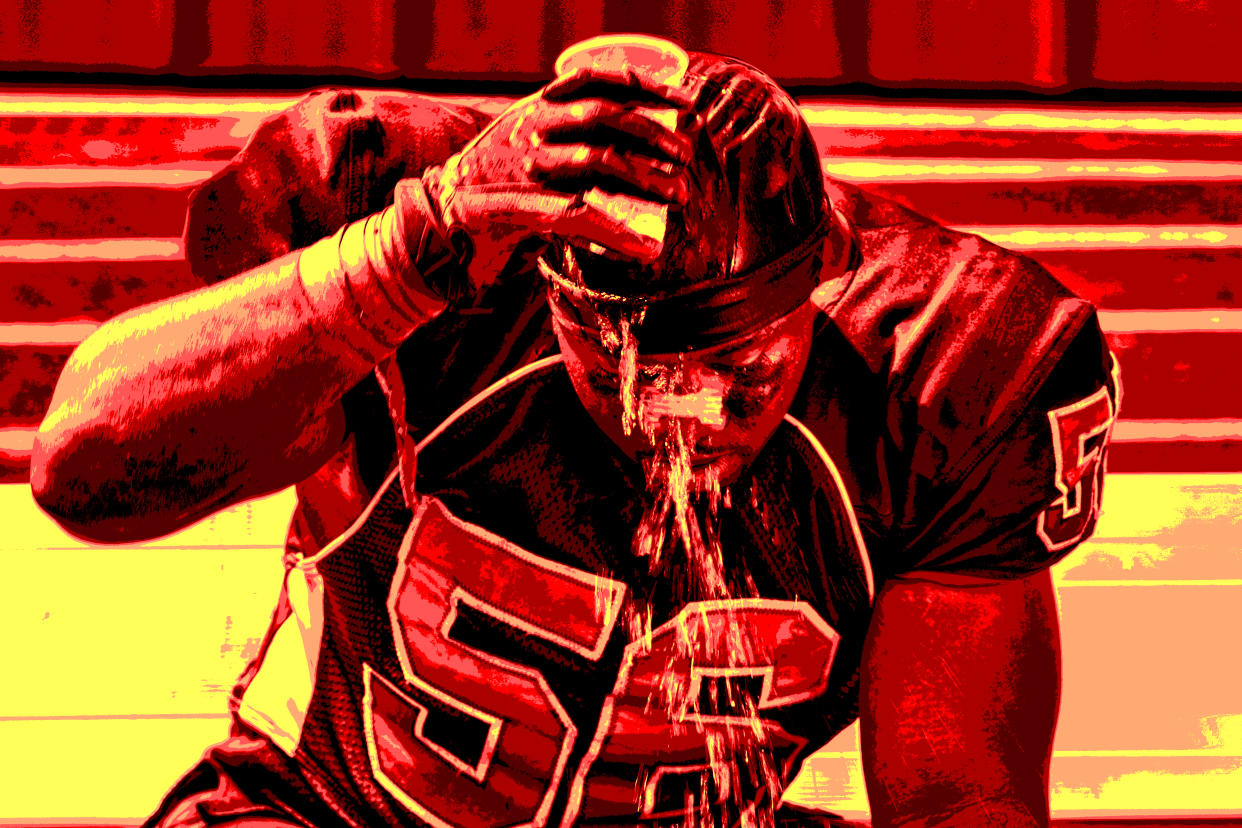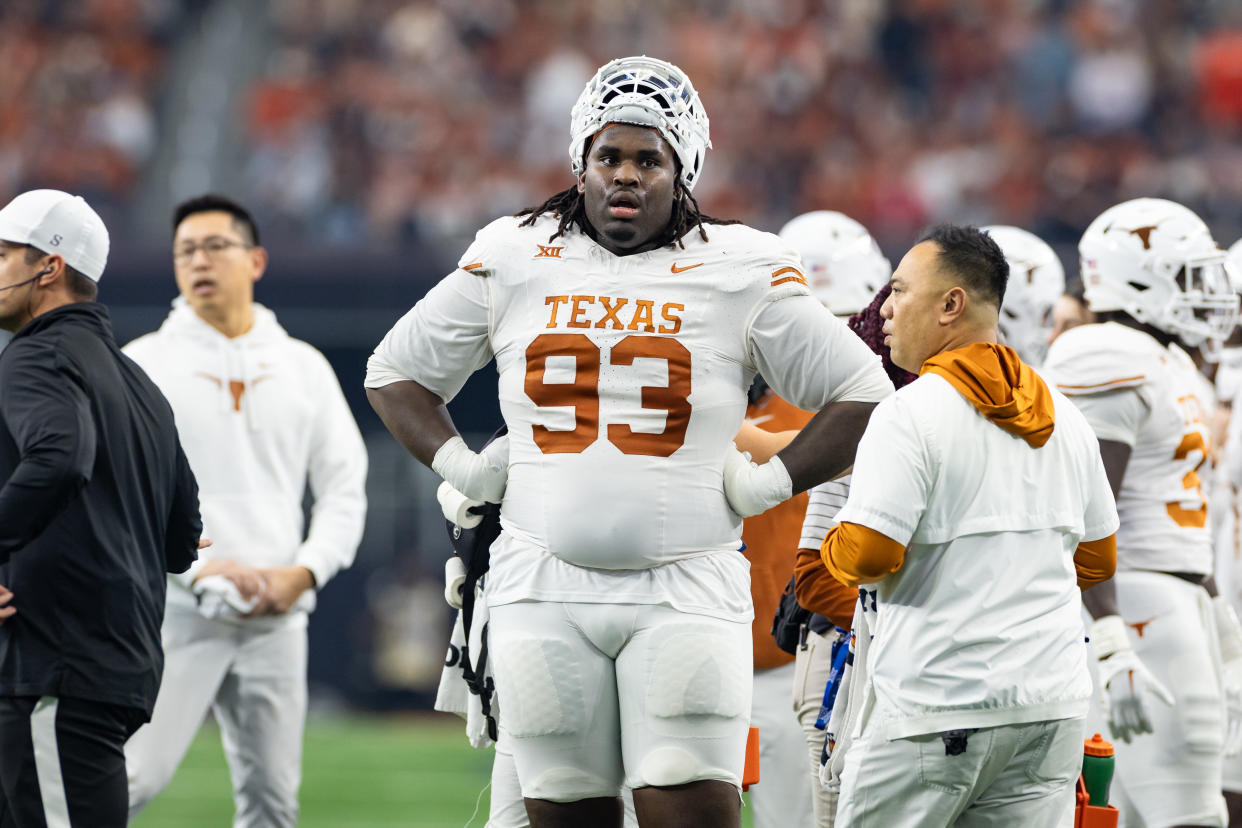Extreme heat is transforming how Texas plays football

When the James Bowie High School varsity football team began its first game of the season last year on the evening of Aug. 24, 2023, the temperature in Austin, Texas, was over 100°F.
By then, the players had already spent weeks practicing in the unrelenting heat of a summer that would go down as the hottest on record for Texas and the United States as a whole (this year is expected to be even hotter, though the data is not yet complete).
“I was fine in the first half,” Justice Trumpler, who played left tackle for Bowie during his senior year, told Yahoo News. “But during halftime, you know, you’re sitting there. You’re not moving. My muscles started getting tense, tight. And then coming out of halftime, I started cramping up.”
Trumpler tried drinking water to alleviate the cramps, but with his body deprived of sodium, that didn’t help and he began throwing up on the sidelines. Yet even with his condition worsening, Trumpler didn’t alert his coaches and continued to play in the stifling heat.
“I’m not trying to go out,” he said. “I’m trying to win.”
Eventually, Trumpler collapsed on the Astroturf. At home after the game, he kept drinking even more water but his vomiting continued until he grew disoriented. Finally, his parents rushed him to a hospital emergency room.
“Several doctors told me he was near death. He was dying just from the heat and overexertion,” Jennifer Norman-Wolfe, Trumpler’s mother, told Fox7 Austin.
Trumpler was lucky. Doctors were able to bring down his body temperature and boost his electrolytes. He was released from the hospital the following day. A year earlier, however, 17-year-old Loney Diaz died after being overcome by heatstroke during a game with the Corpus Christi Wings, a team for homeschooled kids. Like Trumpler, Diaz was overcome by severe body cramps but lost consciousness during the game. By the time he arrived in the ER, it was too late to save him.
“Heat illness during practice or competition is a leading cause of death and disability among high school athletes in the United States,” Michael Sandlin, clinical associate professor in health and kinesiology at Texas A&M University, told university publication Texas A&M Today in 2021, adding that a Centers for Disease Control and Prevention (CDC) study found that the risk to football players, thanks to heat-trapping protective equipment, was 10 times higher than for athletes in other sports.

In Texas, where football is something of a religion, research has shown that average temperatures have risen by 3°F since the dawn of the industrial revolution. In the state’s capital of Austin, there are now 47 more days of temperatures above 100°F than there were in 1970, according to an analysis by Climate Central, and because of a rise in overall humidity, the heat index — what it feels like standing in the shade on a hot day — has grown at an even faster rate.
The rise in both heat and humidity is an especially dangerous combination for human health because when temperatures soar and the air becomes so saturated, sweat is not able to evaporate and cool down the body. In 2023, 334 people died from heat-related causes in Texas, according to data provided by state officials, the largest number ever reported there.
“Texas is a place that is very hot and getting hotter. As long as we continue to burn fossil fuels, it’s going to get hotter and hotter. It really does question the viability of sports like football,” said Austin resident Jeff Goodell, author of the New York Times bestseller The Heat Will Kill You First: Life and Death on a Scorched Planet. “A lot of high schools started their summer football practice last week. It was 105 degrees in Austin. Playing in the field in pads and helmet is kind of terrifying.”
Wet Bulb Globe Temperature

This year, the University Interscholastic League (UIL), which sets athletic rules for and provides guidance to hundreds of schools across the state, released for the first time its recommendations for “heat stress and athletic participation.” Its guidelines, which are not mandatory for schools to follow, rely on the use of a heat measurement known as the Wet Bulb Globe Temperature (WBGT) to determine when conditions make it unsafe to play sports like football.
Whereas a heat index measures the combination of heat and humidity, the WBGT combines the effect of temperature, relative humidity, wind speed and solar radiation using three different thermometers to produce a new reading that schools, coaches and parents can use to determine when to limit physical activity.
The UIL does require Texas schools to set up “rapid cooling zones” at practices and games that are held when the WBGT reaches 80 or higher. Those include “cold-water immersion tubs or tarps that can be filled with ice and water and wrapped around individuals to rapidly cool internal body temperature,” a spokesperson for the organization said in an email.
On its website, the UIL uses a color scale to connote when school officials should alter activity levels. For orange (WBGT is between 87.0 and 90.0), practices should be limited to two hours and “players are restricted to helmet, shoulder pads, and shorts.” For red (WBGT between 90.1 and 92.0), practices should not exceed one hour, include 20-minute rest breaks, and no protective equipment should be worn. For black (WBGT of 92.1 or higher), practice must be scrapped altogether.
‘Try to embrace it’
The new guidelines exemplify how climate change has begun affecting sports.
“At first, there’s some getting used to it. Everybody is making adjustments to their workouts.” said Danny Dailey, assistant coach at South Hills High School in Fort Worth Texas. “Almost every school has a certified athletic trainer. We have two. They monitor our kids very closely. We had a kid last year who we had to take out of a scrimmage and put into an ice bath because he was starting to show signs of overheating.”
For the 2024 season, many schools rescheduled football practices to start at sunrise to avoid the crushing heat that builds later in the day.
“There are days, particularly the last week or so, when the wet bulb has hit black, which means you can’t go out at all,” Dailey said.
Not all of the changes have been universally applauded, however.
“I think practicing earlier and earlier is stupid because how are you going to be able to adapt to the heat if you’re always practicing in the morning? If you’re going to play the game in the afternoon, you should practice in the afternoon,” Trumpler said.
That logic is pervasive in the state. Despite an average daily high temperature this July measuring 103.4°F, University of Texas head coach Steve Sarkisian saw practicing in the heat as an asset for his team.
“For us knowing the first half of the season or so, the majority of our games are gonna be triple digits to 90-something degrees, we have to feel comfortable in that arena,” Sarkisian told Inside Texas in June. “We do try to embrace it. We do think it’s an advantage for us.”

Numerous studies have shown that athletes can build up a tolerance to playing in hotter temperatures, but doing so requires a measured approach and there are limits to what the human body can endure. Critics say those facts are often ignored.
“Texas has this sort-of macho heat thing, that we’re ‘Texas tough’ and we’re not going to let a little heat stop us. Heat builds character and sweat is how you get tough,” Goodell said, adding that such attitudes are “really dangerous.”
Notably, the Longhorns have begun construction on an air-conditioned, indoor training facility. That seems wise, given that a 2024 report by the state climatologist and Texas A&M University found that over the next 12 years Texans “may experience four times as many days with temperatures over 100°F as they did in the 1980s.”
For the schools that can afford to build indoor practice facilities, like Aledo High School in Aledo, Texas, which has won a record 12 state championships, there’s an unfair advantage, Dailey said.
“You do miss a lot of days of workout [due to WBGT restrictions], but having these indoor facilities, those guys can go in,” Dailey said, adding, “I’m in an inner city school, and there’s no way in the world that we would ever have indoor facilities.”
‘Football that lasts for 3 minutes’
Despite research showing summers in Texas will continue to get longer and more intense, the UIL has not yet recommended delaying the start of football season.
“The scheduling would be an absolute nightmare, and I’m going to be honest with you,” Dailey said. “I don’t know if moving that calendar in the state of Texas would ever be an option.”
But with schools moving to adopt other changes, it’s not hard to foresee a time when outdoor football will be much different from the game Trumpler played.
“You can imagine playing football in 120 degree summers, but it’s going to be football that lasts for three minutes and then has a 10-minute water and cooling break and that doesn’t use the same kind of pads. It’s an entirely different game,” Goodell said, adding that if the sport isn’t reimagined, we’re going to see “a lot of dead kids on the field.”


